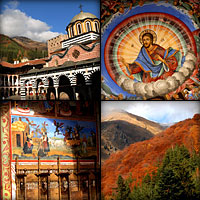Rila, Kyustendil Province, Bulgaria, August 3, 2023
The human conscience is the most difficult thing to heal, says the abbot of the famous Rila Monastery in Bulgaria.
Bishop Evlogy of Adrianople preached about spiritual healing and the role of the Theotokos and the Life-giving Cross during a moleben for the blessing of water on Tuesday, reports Dobrotoliubie, with reference to the Bulgarian Telegraph Agency.
The monks of the monastery founded by the great 9th-10th century ascetic St. John of Rila bring their wonderworking icon of the Mother of God out of the Nativity of the Theotokos Church twice a year, on Bright Friday and on August 1, when the Maccabean Martyrs and the Procession of the Lifegiving Wood of the Cross are celebrated according to the New Calendar.
Speaking of the need for healing, Bp. Evlogy said: “Diseases can be treated—sometimes easier, sometimes more difficult—but human consciences are the most difficult to heal, especially when they are deep asleep in our souls and hearts.”
But we have God and His saints to help us:
Therefore, today we pray that God and the holy Theotokos will awaken the conscience of every single person, so that each one of us can live according to Christ’s teachings and according to Christ’s commandments, which are a condition for eternal life.
Let us pray to the precious Life-giving Cross, to the holy Theotokos, and to all the saints to give us the strength not to fall asleep at night with an unclean and troubled conscience and to wake up in the morning with the intention, desire, and aspiration to live honestly and honorably.
The service was also attended by Fr. John, the abbot of the Ruen Monastery, near the birthplace of St. John of Rila, and other visiting monastics and clergy and faithful.
***
The monastery’s icon of the Most Holy Theotokos is surrounded by particles of the relics of 32 saints, including St. Lazarus, St. Mary Magdalene, the Holy Apostles and Evangelists Matthew and Luke, the Holy Apostle Andrew, the Protomartyr and Archdeacon Stephen, the Prophet Daniel, St. Constantine the Great, the Great Martyr Panteleimon, St. Athanasius the Great, St. Gregory the Great, the Holy Martyr Irene, and more.
According to tradition, the icon was donated in 1173 by the Byzantine Emperor Manuel I Komnenos, who was miraculously head by St. John of Rila.
The emperor suffered from a disease of the hands and while conducting military operations in the area near the town of Serdika, today’s Sofia, he bowed down and prayed before the relics of St. John of Rila, which were in the St. George rotunda in the city. His hands were anointed by the priests with oil from one of the saint’s lampadas and were healed. As a sign of gratitude, the emperor personally left the icon, which until that moment had always been with him during his military campaigns, as his covenant was that it would always accompany the saint’s relics wherever they were. Thus, the icon first ended up in Veliko Tarnovo, and then in the Rila Monastery.
Follow OrthoChristian on Twitter, Vkontakte, Telegram, WhatsApp, MeWe, and Gab!





